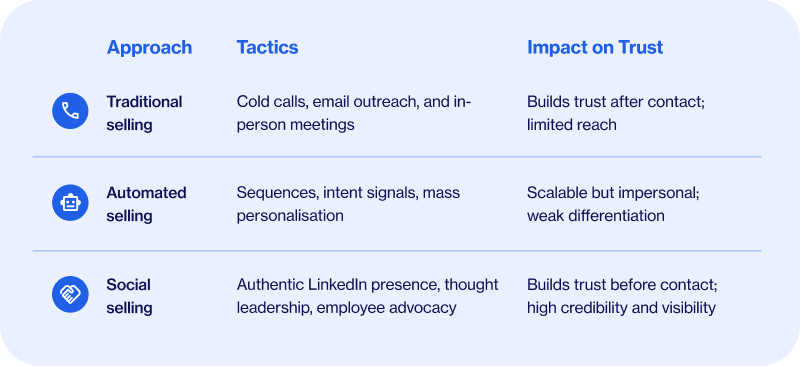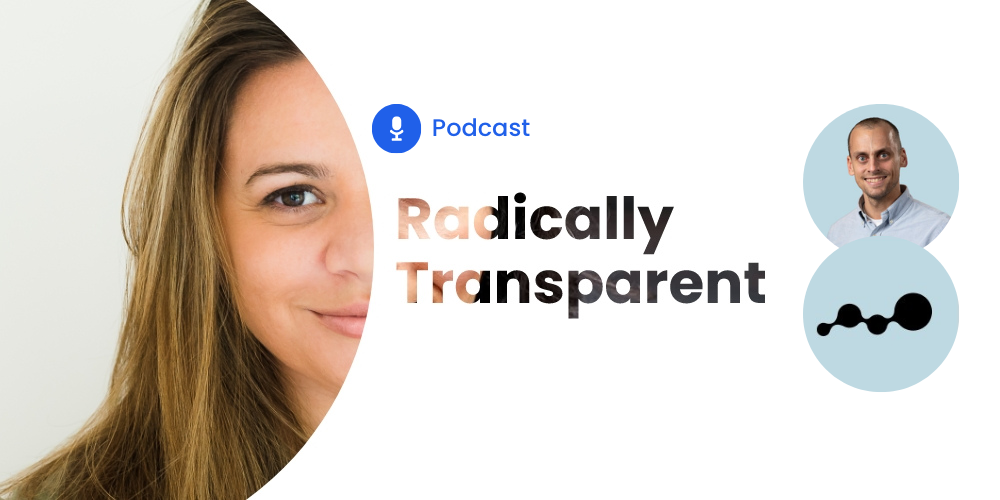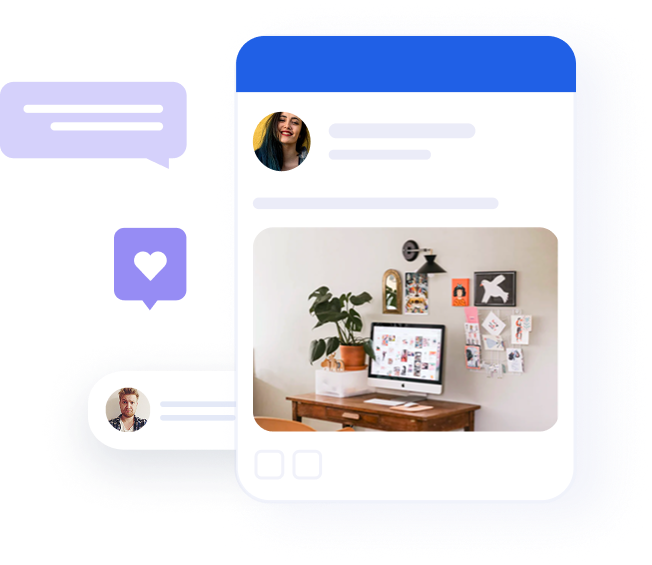When trust is the goal visibility is the route: Why social selling is every B2B team’s advantage

Table of contents
- Trust doesn't live in your CRM; it lives in your feed
- Where trust is built in B2B sales
- Social selling is trust-building in disguise
- Visibility = Credibility: The mindset shift sellers need
- Why sellers show up on LinkedIn
- The role of marketing and leadership
- What social selling looks like across industries
- How to overcome sellers' objections
- The new handshake: Trust built between the calls
- How Oktopost helps sellers build trust at scale
- Final thoughts
Thirty hours door-to-door. A delayed connection in Doha and no spare A380 in sight, but plenty of time to think. After a week of representing Oktopost on a UK trade mission to Australia, shaking hands in boardrooms and rooftop receptions, one word surfaced: not canapés – Trust.
Not as a soft metric. Not as a brand exercise. But as a commercial differentiator. Because in B2B today, the way we earn trust has changed.
Trust doesn’t live in your CRM; it lives in your feed
Buyers are no longer waiting for your call. They’re researching in silence.
Ignoring emails. Comparing options behind the scenes.
If you’re not part of that digital journey, the passive, the silent, social one, you’re not in the consideration set.
And yet, so many B2B teams are still investing in the wrong places:
- Pushing content into inboxes no one reads.
- Automating outreach to the point of irrelevance.
- Paying for “intent signals” that only appear after decisions are made.
Meanwhile, the real buyer journey is happening in plain sight on LinkedIn.
Not paid. Not polished. Organic.
It’s where sellers earn credibility before the first call, subject-matter experts shape the conversation, and employees give a company a human voice.
That’s where trust begins.
Where trust is built in B2B sales

Recommended for further reading
Social selling is trust-building in disguise
Let’s clarify: social selling doesn’t mean pitching on LinkedIn.
It’s not sliding into inboxes with product offers.
It’s building credibility with the public, so when buyers are ready, they know who they want to talk to.
Think of social selling as the modern handshake; it replaces the first impression made in a meeting room.
When sellers consistently share insights, comment on industry topics, and stay visible in their network’s feed, they stop being anonymous reps behind cold emails. They become recognised, trusted voices.
That visibility is magnetic. It draws in hidden buyers, who represent 95% of the market and are not yet in buying mode. It also positions sellers to be top-of-mind when those buyers are ready.
So no, social selling isn’t a “nice-to-have.” It’s how modern trust is built, at scale.
Visibility = Credibility: The mindset shift sellers need
I’d be worried if I were in sales today and not posting on LinkedIn.
Not because of algorithms. Not because someone else is louder.
But because my buyer would already be halfway through their decision, and I’d be nowhere to be seen.
That’s the shift sellers must make: from quota-carrying rep to subject-matter expert.
It’s not about becoming influencers. It’s about being recognisable, reliable voices in your field. The mindset looks like this:
- Treat LinkedIn as a channel for adding value, not for pitching.
- See consistency as a strategy, not a task.
- Understand that credibility earns attention, and trust earns meetings.
Because visibility isn’t vanity, it’s credibility.
And credibility gets you invited into deals long before an RFP hits your inbox.
Why sellers show up on LinkedIn
Once sellers realise that social presence fuels personal growth and sales success, resistance starts to fade.
Here’s what they gain:
Tangible benefits
- Increased visibility with buying personas.
- Faster access to decision-makers.
- Shorter sales cycles due to pre-established trust.
- Better responses from prospects already familiar with their name are needed.
Intangible benefits
- Recognition within the industry.
- Confidence as thought leaders.
- Opportunities to speak, partner, or collaborate.
- A personal brand that outlasts any quarterly target.
When sellers show up, they don’t just drive pipeline; they drive perception.
The role of marketing and leadership
Here’s the truth: most sellers don’t wake up wanting to write LinkedIn content.
They may not know what to say, how to say it, or how to stay consistent.
That’s where marketing and, increasingly, AI, come in.
Marketing teams already excel at storytelling and positioning. With the right enablement, they can turn social into a genuine sales asset:
- Create a content runway. Provide ready-to-share posts, talking points, and multimedia aligned with key campaigns.
- Offer writing support. Help polish posts, ghostwrite when needed, or host short workshops on framing ideas.
- Run an advocacy programme. Use platforms like Oktopost to curate content boards for sales teams, enabling them to post with one click and making it less of a chore.
- Celebrate wins. Spotlight seller posts that gain traction. Recognition fuels consistency.
AI can make this even easier by summarising long-form content into digestible posts, suggesting hooks and hashtags, recommending the best posting times, and identifying hidden buyer engagement behind the scenes.
With these systems in place, social selling stops feeling like “extra work” and starts feeling like a growth channel.
Because sellers shouldn’t be left to figure it out alone.
What social selling looks like across industries
Social selling isn’t one-size-fits-all.
It looks different in tech, legal, and consulting, but the principle is the same: educate, don’t advertise.
- Tech sellers share customer stories, industry takes, and lessons from demos because tech buyers crave peer validation.
- SaaS reps mix insights with authenticity, posting short videos, carousels, and humour to stand out in crowded feeds.
- Legal partners and consultants earn credibility by interpreting new regulations or market shifts, positioning themselves as trusted advisors rather than promoters.
Whatever the field, the formula is constant: show up early, often, and with intent.
How to overcome sellers’ objections
Even with motivation and content support, objections remain. The Oktopost guide captured the most common ones I have come across.
- “I don’t have time.” Make it easy. Advocacy tools deliver ready-to-share content that fits in a scroll break.
- “It doesn’t feel like selling.” Exactly. It’s trust-building that makes selling easier later.
- “No one cares what I post.” Show data from internal wins, proof builds confidence.
- “I’m not a writer.” That’s what AI and marketing support are for; a great post can start with a thoughtful comment or question.
- “Nobody engages with my posts.” Engagement isn’t the only metric. Each post seen by a decision-maker is a micro-interaction that shapes perception.
The answer isn’t to push harder; it’s to make participation frictionless, rewarding, and visibly impactful.
The new handshake: Trust built between the calls
A decade ago, trust was built in the meeting.
Today, it’s built between them.
Buyers are digital-first, self-educated, and often invisible until late in the cycle.
Sellers who wait for inbound leads or rely on cold outbound are missing key opportunities.
The ones who consistently and authentically show up on LinkedIn build relationships that marketing alone can’t.
They warm up prospects long before discovery calls.
They close deals faster because trust is already in place.
At the end of the day, trust does not live in your CRM. It lives in your feed.
How Oktopost helps sellers build trust at scale
Building trust takes consistency. Consistency takes structure.
That’s where Oktopost comes in.
With Oktopost’s employee advocacy solution, marketing and sales teams can:
- Curate and distribute relevant content to sellers effortlessly.
- Track engagement by buyer persona to see real impact.
- Use AI insights to recommend what, when, and how to post.
- Gamify participation to make social presence a habit, not a hassle.
It’s how leading B2B organisations like Grant Thornton Australia, Buker, or Hymans Roberson treat social not as a channel, but as a strategic asset for demand generation, reputation, and client engagement.
The takeaway? If your team isn’t visible where your buyers are, someone else will be.
Final thoughts
Social selling isn’t a marketing trend; it’s the new foundation of B2B trust.
In a world where buyers choose partners long before they fill out a form, visibility is no longer optional; it has become a revenue driver.
If trust is the goal, visibility is the route. And LinkedIn is the road that connects the two.
At Oktopost, we’re helping B2B organisations make that journey easier by turning social presence into business impact and sales teams into trusted industry voices.
I am passionate about helping B2B organisations transform how they connect with buyers through trust, visibility, and authentic conversations on social media. With years of experience bridging sales and marketing teams, I advocate using social selling to drive measurable business impact. – Colin Day, Managing Director, EMEA at Oktopost




